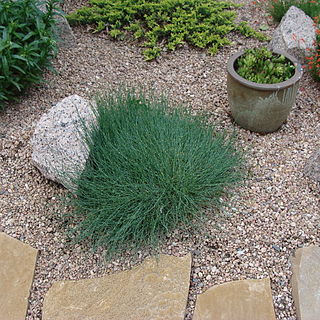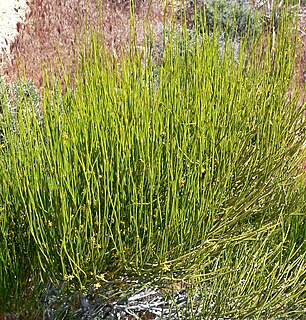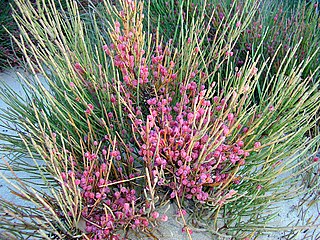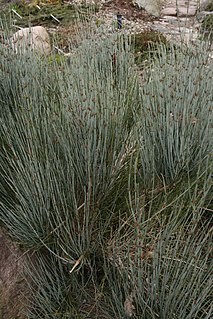
Ephedra distachya is a shrub in the family Ephedraceae that stands about 25 cm to 50 cm high. The shrub grows in many parts of the world, including southern and central Europe and western and central Asia. Its local names include somlatha.

Ephedra is a medicinal preparation from the plant Ephedra sinica. Several additional species belonging to the genus Ephedra have traditionally been used for a variety of medicinal purposes, and are a possible candidate for the soma plant of Indo-Iranian religion. It has been used in traditional Chinese medicine, in which it is referred to as Ma Huang, for more than 2,000 years. Native Americans and Mormon pioneers drank a tea brewed from other Ephedra species, called "Mormon tea" and "Indian tea".
Sea grape or seagrape may refer to:

Ephedra is a genus of gymnosperm shrubs. The various species of Ephedra are widespread in many arid regions of the world, ranging across southwestern North America, southern Europe, northern Africa, southwest and central Asia, northern China and western South America. It is the only extant genus in its family, Ephedraceae, and order, Ephedrales, and one of the three living members of the division Gnetophyta alongside Gnetum and Welwitschia.
There has been much speculation as to the botanical identity of soma or haoma. Soma is a plant described in Hindu sacred texts including the Rigveda, while haoma is a plant described in the Avesta, a collection of Zoroastrian writings. Both names are derived from the Proto-Indo-Iranian *Sauma. Proposed candidates include various species of plants and or fungi. Traditional etymology of Indian Soma is Somalata used traditionally by the Srauta Brahmins called Somayajis whereas the Avestan Haoma is an Ephedra, which are totally unconnected species sourced from different areas. European researchers suggest other plants, such as the perennial Peganum harmala, Nelumbo nucifera, Cannabis sativa, and the sugarcane species Tripidium bengalense ; while fungal candidates include the fly-agaric mushroom Amanita muscaria, the psilocybin-containing mushroom Psilocybe cubensis, and the ergot fungus Claviceps purpurea. Other scholarly proposals include mixtures of these candidates with each other and with other substances.

Ephedra californica is a species of Ephedra, known by the common names California jointfir, California ephedra, desert tea, Mormon tea, and cañatillo.

Ephedra funerea is a species of Ephedra, known by the common name Death Valley jointfir, Death Valley ephedra, or Mormon Tea.

Ephedra viridis, known by the common names green Mormon tea, green ephedra, and Indian tea, is a species of Ephedra. It is indigenous to the Western United States, where it is a member of varied scrub, woodland, desert, and open habitats. It grows at 900–2,300 metres (3,000–7,500 ft) elevations.

Ephedra fasciculata is a species of plant in the Ephedraceae family. Common names are Arizona ephedra, Arizona jointfir, and desert Mormon-tea.
Ephedra alata is a species of Ephedra. These plants are perennial and xerophytic gymnosperm shrubs.
Ephedra cutleri, the Navajo ephedra or Cutler's jointfir, is a species of Ephedra that is native to the Southwestern United States.

Ephedra fragilis, commonly named the joint pine, is a species of Ephedra that is native to the western Mediterranean region of southern Europe and Northern Africa, and from Madeira and the Canary Islands in the Atlantic.

Ephedra intermedia, with the Chinese common name of Zhong Ma Huang, is a species of Ephedra that is native to Siberia, Central Asia, Iran, Afghanistan, Pakistan, the western Himalayas, Tibet, Mongolia, and China.

Ephedra nevadensis, commonly known as Nevada ephedra, gray ephedra, Mormon tea and Nevada jointfir, is a species of gymnosperm native to dry areas of western North America.

Apigeninidin is a chemical compound belonging to the 3-deoxyanthocyanidins and that can be found in the Patagonian plant Ephedra frustillata and in the soybean. Apigeninidin is one of the principal pigments found in sorghum. Extremely high level of apigeninidin (49 mg/g) has been documented in sorghum leaf sheath. Like all anthocyanidins it exists in a variety of tautomers depending on pH and hydration, several of these bare the distinctive pyrylium core.

Eriogonum soredium is a species of wild buckwheat known by the common name Frisco buckwheat. It is endemic to Utah in the United States, where it is known only from Beaver County. There are four populations, all located in the San Francisco Mountains. It is a candidate for federal protection.
Ephedra pedunculata, common name Clap-weed, vine Mormon tea or Comida de Vívora, is a plant species native to southern Texas and to Mexico as far south as Zacatecas. It grows in sandy or rocky slopes and outcrops.

Ephedra breana is a species of Ephedra growing from northwest Argentina through to Chile and Bolivia.

Ephedra coryi, also known as Cory's joint-fir, is a rare, reed-like gymnosperm native to sandy, semi-arid areas of the North American South and Southwest.














